Authors:
ABSTRACT
Aim
The purpose of this report is to evaluate the epidemiological aspects of intrusion that occur against upper incisors in
primary dentition, to determine the statistic correlation of developmental disturbances to permanent teeth in relation to age of children at
the time of trauma.
Methods
A retrospective study was performed based on radiographic and clinical data of 34
intruded incisors in 30 patients aged between 12 and 60 months. Baseline data were collected in a questionnaire designed following the
guidelines of the IADT-Italy. The descriptive statistical analysis between the different variables was performed with the Chi-squared test
and the level of significance was set at 5. The following parameters were considered: gender, age of patient at the time of
injury, emergency treatment, clinical signs (vitality, mobility, spontaneous pain, colour change), presence of complications, degree of
spontaneous re-eruption and possible developmental disorders to the following tooth.
Results
Intrusive luxation is not statistically
related to gender. During the first 6-month follow-ups, 20 incisors belonging to 12 subjects aged between 12-24 months at the time of
intrusion exhibited pulpal necrosis. The highest rate of total spontaneous re-eruption occurred in incisors intruded at 12-24 months. The
likelihood of spontaneous re-eruption decreased with the child's age. A significant correlation between mobility at clinical follow-up and
developmental disorders in permanent teeth was found, whereas a statistical correlation between age of patient at the time of trauma
and sequelae was not pointed out, even if 17 primary incisors intruded at 12-24 months did not develop an arrest of root formation.
Conclusion
The most traumatic intrusions in primary dentition occurs between 12 and 24 months of age, the most common cause
being fall while walking. Intruded incisors with moderate mobility developed enamel hypoplasia and ectopic eruption. There was no
significant correlation between age at the time of intrusion and type of subsequent developmental disturbances.
PLUMX METRICS
Publication date:
Keywords:
Issue:
Vol.15 – n.2/2014
Page:
Publisher:
Cite:
Harvard: A. Caprioglio, G. S. Salone, C. Mangano, C. Caprioglio, D. Caprioglio (2014) "Intrusive luxation of primary upper incisors and sequelae on permanent successors: a clinical follow-up study", European Journal of Paediatric Dentistry, 15(2), pp101-106. doi:
Copyright (c) 2021 Ariesdue

This work is licensed under a Creative Commons Attribution-NonCommercial 4.0 International License.
